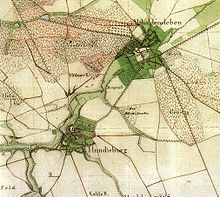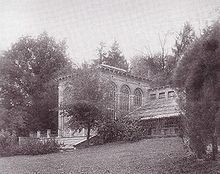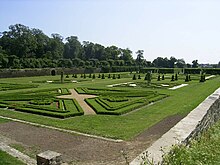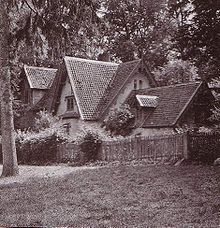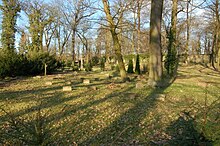Althaldensleben-Hundisburg Landscape Park
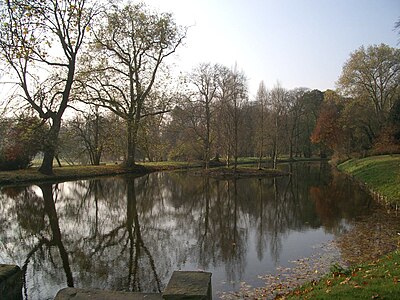
The design of the Althaldensleben-Hundisburg landscape park began in the early 19th century. In addition to the industrial establishments that were also built in Althaldensleben and Hundisburg , it became a popular destination throughout Germany for important personalities of the time. After 1945, the approximately 100-hectare ensemble was no longer maintained; some of it was misappropriated. The park was then reconstructed with interruptions since the late 1970s. In 2004 it became part of the Garden Dreams Saxony-Anhalt project . The park is considered the third largest of its kind in Saxony-Anhalt. By including the gardens of the former Althaldensleben monastery and the baroque parks of Hundisburg , it is one of the most important park ensembles in Germany, and its importance as a cultural landscape can be compared with the gardens of the Wörlitz and Potsdam landscape parks. The park belongs to the city Haldensleben (district Hundisburg / Althaldensleben) in the Börde district of the administrative district of Magdeburg .
history
The historical gardens and parks of Hundisburg Palace and Althaldensleben Monastery go back to the late Middle Ages in their predecessors.
From 1693 Johann Friedrich II. Von Alvensleben had a baroque garden laid out for the Hundisburger Schloss, which he had extensively rebuilt. Hermann Korb was the responsible architect. In 1740 the design of the baroque garden was completed with the construction of the “Paris Gate” under Friedrich Anton Ulrich von Alvensleben . As early as 1753, Gebhard August von Alvensleben adapted a part ("hedge garden") of the complex as "English part" to the new style of the English landscape garden . Around 1800, parts of the previously south-facing park under Philipp Karl von Alvensleben were increasingly placed in relation to the opposite Beberaue .
The monastery complex in Althaldensleben already included a small vineyard, a hop garden and a tree garden in the 16th century. The existence of these three smaller plants plus the usual monastery garden with vegetable and herb cultures is also documented for the 17th century. A site plan of the monastery from 1810 shows that at that time, in addition to usefulness aspects, there were already smaller gardens for recreation. In addition to a "pleasure garden" designed as an ornamental garden, there was a regularly structured, walled "large monastery garden" in the inner courtyard. This park, which began south of the monastery, extended to the Beber. Separated from this complex there was also a “garden of the abbess”, in which there was a small summer house. The existence of a gardener and a corresponding house are also documented from 1810.
Johann Gottlob Nathusius' vision
In 1810 the rich Magdeburg merchant Johann Gottlob Nathusius acquired the secularized monastery estate Althaldensleben and in the following year also the neighboring Hundisburg Castle with its estate and lands. Under him and his sons, the 100-hectare landscaped garden was built by the end of the 19th century, which has since connected the two properties.
When he was still living in Magdeburg, Nathusius had laid out a much-noticed park there. At the end of the 18th century he had bought land at the tip of the then uninhabited Werder Island in the Elbe and merged it into a park. In addition to the construction of a summer house, a gardener's accommodation and a greenhouse, many domestic and foreign trees were planted there. At the top of the Werder an artificial mountain with roses was created, the "Rosenberg". In the greenhouse, Nathusius grew pineapples and other exotic plants. The park he created was open to everyone. At that time it was common for foreign visitors to Magdeburg to visit the park of the merchant Nathusius on the Werder as the next best attraction after visiting the Magdeburg Cathedral .
Nathusius wanted to implement the experiences made at the Magdeburg Werder in his new field of activity on a larger scale. He used much of the profits from his factories and trading businesses to design the new park.
The Bebertal in the area of today's landscape park was still dominated by agriculture in the 18th century with floodplain meadows and unforested valley slopes. Probably from 1821 onwards, Nathusius began to lay out the landscape park connecting the two properties. However, the separation required to design the system dragged on for years. The peak of the plantings therefore seems to have been reached between 1827 and 1836. Nathusius, who died in 1835, was no longer able to see the realization of his plan for a coherent landscape park.
The plan for the English-style park may have come from the landscape architect Daniel Engelhard from Kassel, whom Nathusius probably met in 1808 on his first visit to Kassel on the occasion of the opening of the Reichstag (July 2, 1808). Heinrich Reinhardt (1763–1826) and Philipp Christian Karf (1776–1835) were the first art gardeners that Nathusius employed during the construction phase.
The director of the Botanical Garden of the University of Halle (Saale), Kurt Sprengel , advised on the selection of trees . Primarily hardwood species of North American origin were used. Sprengel also hired his ward, August Dieskau (1805–1889), who would later grow Nathusius' pigeon apple and - together with Georg Alvensleben (* 1806) - be the head gardener of the park. The trees required for the park were grown in the company's own commercial nursery in Althaldensleben . Nathusius named a specially bred and planted pear variety after his wife Luise, née. Engelhardt as "Gute Luise". The tutor of the Nathusius children, Julius Elster (* 1803), also played an important role in the design of the park.
The basic structure of the park with the planned wide meadow spaces, the inclusion of well-tended agricultural areas as well as the creation of walking paths, vantage points and visual axes followed the ideas of the design type of the ornamental farm at the time . The structure corresponded to the nature of the founder, who placed no value on display and always tried to combine the beautiful with the useful. The plantings were concentrated on the agriculturally unusable slopes and valley edges, leaving the park with a larger agriculturally used area in the valley floor. With the creation of the "Rousseau Island" named after Jean-Jacques Rousseau and the designation of the "Napoleon pastures", the ideals of the French Revolution and the attitude of the park creator, which was inclined to Napoleon , were also met.
Continuation among the offspring
After Nathusius' death in 1835, his sons took over the Althaldensleben and Hundisburg estates and thus also the landscaped park that was still being developed. Philipp von Nathusius initially worked in Althaldensleben , and then his younger brother Heinrich from 1849 . The oldest brother Hermann had already taken over the business in Hundisburg in 1830 . Even if the sons were not as interested in gardening as the father, they continued the plan to build the landscape park and developed it further in part. The park in its current structure was only created through them. Hermann von Nathusius conceived the Hundisburger part in the 1840s and in Althaldensleben the reshaping under Heinrich von Nathusius dominated in the 1860s.
Smaller buildings in particular, which complemented the park in a meaningful way, were erected or refined. This is how the "Palm House", which was demolished after the Second World War, was built on the Althaldensleber side. Heinrich von Nathusius had this water-heated greenhouse built with three wings. Additional new plantings were carried out in Althaldensleben in the 1860s. For Marie Nathusius , the wife of Philipp, who later became a well-known writer, a small piece of land was designed near the Althaldensleber manor house. "Mariechens Pastorengarten" was a garden surrounded by cherry trees with a small wooden pavilion and a bell.
In the Hundisburger part of the park, various utility and residential buildings in the English cottage style (such as the forester's house and Niedermühle ) were built or designed. Gustav Maass , who later became an important botanist, worked as a gardener's assistant on the Hundisburger side . The last owner of the Hundisburg before the expropriation after the war, Gottlob Karl von Nathusius , an enthusiastic hobby ornithologist , had the park declared a bird sanctuary . Up to 1,000 nest boxes, mainly for starlings and pied flycatchers, were attached. Dying trees were used as nesting sites for cave breeders.
In 1895 the former monastery estate Althaldensleben was sold by the descendants of Heinrich von Nathusius to Carl Dippe, the owner of a seed breeding company in Quedlinburg . From him it passed to his son Gustav von Dippe and in 1911 to his brother-in-law Hans von Mackensen. Finally in 1932 Hugo Henkel , the managing partner of the Henkel company from Düsseldorf, bought it at a foreclosure auction. The landscape park, which partly belongs to the Althaldensleber Gut, was no longer preserved in its entirety. The new owners in Althaldensleben made changes that were detrimental to the original idea. The part of the park below the former castle walls, which had been used as a family burial place since the death of Johann Gottlob Nathusius, as well as the “Jägerhaus” remained in the possession of the Althaldensleber line of Nathusius after the sale and were separated. In 1934 the DDG visited the park.
GDR
After the Second World War , the monastery park fell to the city of Haldensleben as part of the land reform . Shortly after the castle fire in 1945, efforts were made to place the facilities under protection, which, however, could not prevent decades of neglect and misuse. The then mayor Müller was also the district commissioner for nature conservation and campaigned with great commitment until 1948 for the preservation and care of the once famous park and against the planned allocation to new farmers. These efforts were not granted lasting success. There was logging, plantations overgrown and unsuitable functional and residential buildings and sports facilities being erected.
From 1948 to 1976, Bruno Weber was intensely committed to the park as a nature conservation officer. From 1978 committed park guards joined forces to form a “park active” and began to reconstruct the park.
Over the years, Parkaktiv grew to 85 volunteers. At the instigation of one of the initiators, the local vocational school teacher Hartmut Neumann, the GDR Institute for the Preservation of Monuments carried out soil soundings in order to find out the old course of the paths and visual axes. The Parkaktiv and other institutions took care of the restoration of water and path structures, carried out reforestation and replanting. The park has been declared an area and natural monument.
After the turn
The measures to rescue and regain the park ensemble intensified from 1990 onwards. Inspired by citizens' initiatives in Althaldensleben and Hundisburg, the city of Haldensleben, after the incorporation of Hundisburg in 1994, reunited the dismembered landscape park to form a unit under ownership law and commissioned the CULTURAL landscape of Haldensleben- Hundisburg eV with the restoration of the total work of art in terms of monument preservation. For this purpose, the association maintains a palace and garden administration at Hundisburg Palace under the direction of Dr. Harald Blanke.
The former monastery in Althaldensleben was rededicated as a vocational school center. After a five-year conversion, new building and renovation phase, the center of the vocational schools in Haldensleben in the Börde district was able to open for 1,800 students, including around 1,000 full-time students.
In 2001 the park was accepted as one of 40 in the garden dreams program of the state of Saxony-Anhalt . The city of Haldensleben won a silver medal in the “ Entente Florale Germany ” competition.
Meaning today
The landscape park with the adjoining baroque garden of Hundisburger Schloss is now under the official type designation Reconstructed Baroque Garden of the early 18th century with landscaped areas (Hundisburg) and landscape park of the 19th century (Althaldensleben) . The baroque gardens of the Hundisburg are among the oldest classical French gardens in Germany. The area of the entire park ensemble is around 100 hectares. This cultural landscape is protected several times: as a monument (castle and park), as part of the landscape protection area (LSG) “ Flechtinger Höhenzug ” and as (GLB) Protected Landscape Part (GLB) “Beberlauf”.
It is a public facility that is accessible all year round with free admission. There is an educational trail in the park.
Prehistoric and early historical settlement
The landscape park is part of the "historical square mile" that extends between Haldensleben, Süplingen , Bebertal and Hundisburg. There are a large number of archaeological sites on both sides of the Beber . The "park gravel pit" is also a prehistoric site.
The area was already settled in prehistory , 250,000 years ago Paleolithic hunters and gatherers lived here , whose tools and remains of the large mammals that lived at the time, such as the mammoth and woolly rhinoceros , were found in the beber deposits. Relics of prehistoric and early history are now included in the park's educational trail. At the intersection of the Beber and the Mittelland Canal, the State Office for Monument Preservation and Archeology of Saxony-Anhalt has been carrying out extensive archaeological investigations since 2010, which have produced extremely interesting findings. In addition to house floor plans that were previously completely unknown for the region, there are hundreds of Bronze Age storage pits with some unusual finds, including a Bronze Age stag ax decorated with circular eye motifs . Such a decorated ax was also found in the mouth of the Isar near Moos ( Deggendorf district ).

Significant visitors
Both in the time of Johann Gottlob Nathusius and in the years in which his sons Philipp and Heinrich von Nathusius (in Althaldensleben) and Hermann von Nathusius (in Hundisburg) lived, many well-known personalities came to visit - attracted by relevant publications. In addition to the landscape park, the Nathusius' industrial establishments and later the hospitable, political-artistic home of Philipp and Marie Nathusius were also reasons for visits by, among others:
- Bettina von Arnim from October 2nd to 5th, 1839
- Emanuel Geibel
- Hoffmann von Fallersleben , from August 3 to 5, 1842, from April 21 to May 24, 1843 and from June 16, 1846 for a further six weeks
- Peter Joseph Lenné , on the occasion of a six-day visit for project planning work in Magdeburg in 1824
- Julius Mosen in 1844
- Wilhelm of Prussia (1882–1951) , the former Crown Prince, 1924
- Prince Hermann Pückler-Muskau
- Fritz Reuter , at the age of twelve, accompanied by his father, the Stavenhagen mayor Georg Johann Reuter, on an educational trip to Braunschweig
- Wilhelm Sello .
- Albrecht Daniel Thaer
- Ludwig Reinhold Walesrode (1810–1889), journalist and writer, July 1843
Karl Immermann processed his impressions from a visit to Althaldensleben and Hundisburg in his great family novel The Epigonen in 1836 . The depictions of the landscape in the novel clearly refer to the park, which he visited in April 1824: “... the battlements of the Count's Castle rose on the highest hill in the area, and the towers of the monastery below. The uncle used both properties ... "
Even Karl Rosenkranz spent as a boy in 1821 and 1822 part of his holidays in the parks.
Today's structure of the park
With the former Althaldensleben monastery and Hundisburg Castle, the landscape park has two equal points of reference and extends in the Beber valley between the two former mansions.
The parks are bordered in the northeast by the former monastery residential building. They include the old castle wall and the Nathusius family cemetery, which is still in use today. In the southwest the park ends below the Hundisburg castle hill. In the northwest, the path from the Jägerhaus in Althaldensleben to the forester's house in Hundisburg, in the southeast, the road between Althaldensleben and Hundisburg limits the facility. The main design element is a row of parallel meadows, separated by groups of trees, which are connected to each other by visual axes.
The castle park, which extends eastward from Hundisburg Castle, is not part of the landscape park. The baroque style of these formerly important parks, which was not preserved under Nathusius and his descendants, has been reconstructed in recent years based on the oldest of eight historical garden inventories. The current form of the tiered baroque park dates from the late 17th century.
Park components
Parts of the ajar baroque palace gardens of Hundisburg are also listed here, although it does not belong to the landscape park.
Hundisburg area above
- Baroque garden with upper and lower pleasure garden and grotto
- Paris gate
- Hundisburger Hund (cast zinc sculpture of the Florentine Wolfhound)
- English section with pedestal avenue and Schneckenberg
- Small gardener's house
- Former orangery
- Tree and field garden with historical fruit varieties
- beekeeping
- Park gravel pit
Hundisburg area below
- Niedermühle
- Niedermühlenwiese
- Ranger's cottage
- Paddock
- Forest on the Hühnerberg
- Forest quarry pond
- Forest quarry meadow
- Black hole (pond)
- Lower cow pond
Area monastery
- Orchards
- Oil mill with a dry mill ditch
- Rousseau Island in the Swan Pond
- Nathusius family cemetery
- Winter garden
- Nathusius way
- Monastery park
- Former gardening area
- Lenne way
- Greenhouse (no longer available)
- Palm house (no longer available)
- Hunter's House
- Apiary (no longer available)
- Bleichhofgarten
- South meadow
- Burgwiese
- Medieval ramparts
- White bridge
- Stone table with Napoleon willows
Represented tree species
Today there are around 150 different tree species, some of them exotic, in the landscape park. This includes a ginkgo, presumably from the 18th century, with a trunk circumference of 3.90 meters. There is a Japanese sophora tree that blooms in August and very old linden poplars. There are also the following types:
- Maple-leaved plane tree
- Linden (shape: hanging silver linden )
- Blood beech
- English oak
- Cornelian cherry
- Hanging beech
- Sycamore maple
- Norway maple (forms: Acer platanoides "Schwedleri" and Acer cappadocicum "Kolchischer")
- Pillar oak
- Summer lime tree
- Butternut
- Silver maple
- Giant tree of life
- Black alder
- Appalachian horse chestnut or yellow horse chestnut
- Hawker horse chestnut or shrub horse chestnut
- Cucumber Magnolia
- Two-row bald cypress or real bald cypress
- Swamp oak
- Flutter elm
- Hickory (form: bitter nut hickory )
- Zerr oak
literature
- Detlef Gärtner: The whole park was poetic enough for me. Althaldensleben-Hundisburg. In the mirror of 19th century literature . Cultural landscape Haldensleben-Hundisburg e. V. (Ed.), Haldensleben-Hundisburg 1997, OCLC 258181425 .
- Ulrich Hauer: Of art gardeners and garden art. The gardeners and gardens of the Nathusius family in Althaldensleben and Hundisburg. Cultural landscape Haldensleben-Hundisburg e. V. and Museum Haldensleben (ed.), Haldensleben-Hundisburg 2005, DNB 978432916 .
- Elsbeth of Nathusius: Johann Gottlob Nathusius. A pioneer in German industry . German publishing company, Stuttgart / Berlin 1915.
- Hartmut Neumann, Gerhard Storaczek, Ulrich Hauer, The natural history and historical nature trail Althaldensleben-Hundisburg . Youth club of the FDJ in the district museum Haldensleben (Hrsg.), Haldensleben 1984, OCLC 75142736 .
- Matthias Puhle (Ed.): The soul wants to fly. A woman's life between adjustment and departure. Marie Nathusius (1817–1857), (Magdeburg Museum Writings No. 10, book accompanying the exhibition). Mitteldeutscher Verlag, Magdeburg 2007, ISBN 978-3-89812-466-9 .
- Gabriele Reuter : Green tendrils around old pictures. A German family novel. In: Grote's collection of works by contemporary writers. Volume 228, G. Grote'sche Verlagbuchhandlung, Berlin 1937.
Web links
- Video: Excursion tip in the Alt-Haldensleben landscape park
- Ecomusee Haldensleben-Hundisburg
- Museum Haldensleben
- Hundisburg Castle
- House of the Forest (park tours)
- Garden dreams - historical parks in Saxony-Anhalt
Individual evidence
- ↑ Detlef Gärtner: There was enough poetry for me ... , p. 1.
- ↑ according to State Working Group for Vacation and Leisure in the State of Saxony-Anhalt e. V., Sugar Route, Hundisburg ( Memento from May 14, 2006 in the Internet Archive )
- ↑ according to Jugendherberge.de ( Memento from May 29, 2007 in the Internet Archive )
- ↑ Schmettausche Karte, end of 18th century, at: Staatsbibliothek zu Berlin, Preußischer Kulturbesitz, map department, used in: Ulrich Hauer : Von Kunstgärtnern und Gartenkunst ... , p. 19.
- ↑ a b c d e f Overall concept ( Memento from February 23, 2006 in the Internet Archive ) (PDF; 2.3 MB) on Garden Dreams Saxony-Anhalt , at Sachsen-Anhalt.de
- ↑ a b c d e Ulrich Hauer: Of art gardeners and garden art ...
- ↑ Floor plan and special situation plan of the women Closter Althaldensleben, its economic courtyard and those farmsteads and facilities belonging to the Closter that are located close to the Closter. Exactly measured, plotted and drawn from the 9th up to and including the 16th February 1810 by killers . Copied by Hermann Klaus, 1898, Museum Haldensleben, used in: Ulrich Hauer: Von Kunstgärtnern und Gartenkunst ... , p. 11.
- ↑ Measuring table sheet of the Prussian land survey of 1823, at: State Library of Berlin, Prussian Cultural Heritage, Map Department, used in: Ulrich Hauer: Von Kunstgärtnern und Gartenkunst ... , p. 27.
- ↑ Elsbeth von Nathusius: Johann Gottlob Nathusius ...
- ↑ according to Article Nathusius brought industry to the country . In: Volksstimme am Sonntag. April 23, 1995, p. 6.
- ↑ a b c according to Ada Groissant: Where Gneisenau and Fallersleben stayed. Immermann Circle of Friends met in a classic natural monument in Althaldensleben. In: Haldensleber newspaper. July 13, 1987.
- ↑ " ... finally in 1834 the systems were given their shape by the current owner ... ", according to L. Wittmack: The facilities in Althaldensleben and Hundisburg . In: Weekly of the Association for the Promotion of Horticulture. 1868, p. 357 ff.
- ↑ Johann Daniel Wilhelm Eduard Engelhard (* April 12, 1788; † October 13, 1856), architect and landscape planner in Kassel (according to: Daniel Engelhard. In: arch INFORM ; accessed on January 2, 2010.), including from the Breakfast Temple (PDF; 456 kB) above the valley / Karlsaue (1806) and the classicist church in Heimarshausen (1833–1834). His son was the later Kassel court building director Gottlob Engelhard (December 18, 1812 - April 13, 1876), who designed the former Kassel main station.
- ↑ Through the agency of Daniel Engelhard, Nathusius rented a room from the family of the architect's uncle, the war councilor Johann Philipp Engelhard in Kassel, where he met his future wife, according to Gabriele Reuter: Green tendrils around old pictures .... see LitVerz
- ↑ a b c according to Page no longer available , search in web archives: Information at BBS-Ohrekreis.de
- ↑ Otto Dieskau: From Althaldensleben's past. V part, no. 24: Our monastery estate park (pp. 9–16), Verlag von Simmerlein, Neuhaldensleben / Althaldensleben 1923.
- ↑ a b c according to Landscape park Althaldensleben-Hundisburg, in: unknown directory of landscape parks, presumably publisher is the DDG, around 1989, p. 24 ff.
- ↑ The design was based on the original burial site of the philosopher in the park of Ermenonville (Oise) . Such a design element was often used in the landscape gardens of the 19th century, which were influenced by the Enlightenment
- ↑ according to Info on the website of the Alvensleben Family Association
- ↑ At that time, however, not yet ennobled
- ↑ The so-called “palm house” was actually just one wing of the building; orange trees, conifers and camellias were grown in the other two parts
- ^ Elise Gründler: Marie Nathusius. A picture of life. In a new presentation. Friedrich Andreas Perthes AG, Gotha 1909, p. 90.
- ↑ later ennobled
- ↑ more precisely: Carl Hans Ferdinand Mackensen von Astfeld, husband of Margarete Ottilie von Dippe
- ↑ Source: Information board at the park entrance in Althaldensleben as part of the "Garden Dreams", City of Haldensleben
- ↑ Hartmut Neumann: Park ownership is also an obligation ... For 45 years, conservationists have been fighting to look after the landscape in Althaldensleber Park. in an unknown daily newspaper from June 1992.
- ↑ Steffen Kawelke: A jewel of the Börde receives polish again. Althaldensleber Park is being brought back to life . In: Magdeburger Volksstimme from October 25, 1985, in supplement: Natur und Heimat , Magdeburg 1985, p. 5 (of the supplement)
- ^ Information at Haldensleben-dig.de, a website of the city of Haldensleben
- ↑ So stated Peter Wilhelm Behrends in his Neuhaldenslebischen Kreis-Chronik about 1830: "Come and see whether nature and art are not building an Eden here"
- ↑ List acc. Detlef Gärtner: It wrote…. P. 34 ff., Elsbeth von Nathusius: Johann Gottlob Nathusius,… , P. 273 ff. And a.
- ^ Hartmut Neumann: Lenné in Haldensleben. Before the 200th birthday of the famous garden architect and city planner . In: Volksstimme and Haldensleber Zeitung of April 27, 1988.
- ^ With Gabriele Reuter: Green tendrils around old pictures. On p. 221, Prince Pückler mentions on the occasion of a visit to Althaldensleben with Johann Gottlob Nathusius: I come directly from Weimar, where I had a stimulating exchange of views with Goethe about the layout of parks and gardens, our two favorite games. The old master then thought with obvious pleasure of the young architect Engelhard's visit and pointed out the parks with which he so sensibly connected the two estates, Althaldensleben and Hundisburg.
- ^ Wolfgang Ollrog: Archive for family research and all related areas with practical research assistance. 47th year, issue 81/82, February 1981, ISSN 0003-9403 , CA Starke, Limburg / Lahn 1981.
- ^ Adolf Wilbrandt (Ed.): Fritz Reuter, Nachgelassene Schriften. First part, Wismar et al. 1874, p. 5.
- ↑ in Elsbeth von Nathusius: Johann Gottlob Nathusius,…. On p. 276 he is only named as the Potsdam gardening director Sello . It could also have been his relative Hermann Sello , see also the overview of the Sellos family
- ^ Karl Immermann: The Epigones. Family Memoirs in Nine Books. 1823–1835, based on the first edition from 1836, Peter Hasubeck (Ed.), Munich 1981, p. 399.
- ↑ according to Chapter IV. In: Karl Rosenkranz: From Magdeburg to Königsberg , Erich Koschny / L. Heimann Verlag, Leipzig 1878 Retrieved from Zeno.org
- ^ Photograph of a plaque from the city of Haldensleben that was set up in the 1980s at the entrance to the park
- ↑ Remnants of the castle built by the Margraves of Haldensleben in 966: castle hill, fortification moat and rampart
- ^ A b Manfred Zander: With Napoleon came Nathusius' hour. from the series: Garden Dreams (6th part): Baroque Garden Hundisburg and Landscape Park Althaldensleben , unknown daily newspaper in August 2006.
Coordinates: 52 ° 15 ′ 28.5 ″ N , 11 ° 24 ′ 28.9 ″ E

